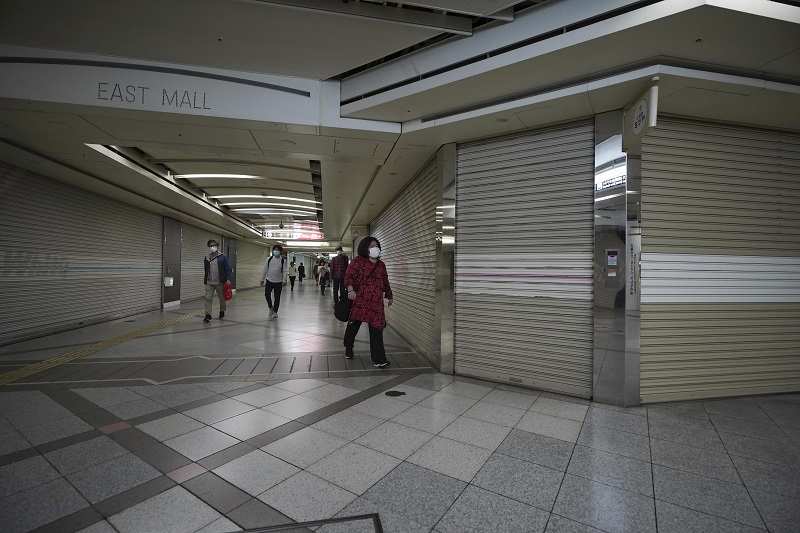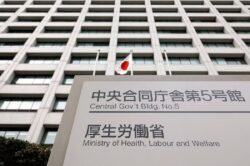
People walk past shuttered shops in an underground arcade in Kita Ward, Osaka on April 25.
18:22 JST, May 8, 2021
The government has decided to extend the third coronavirus state of emergency to be declared since the outbreak of the pandemic. Stricter measures have been effective to some extent in curbing the flow of people but have failed to cause any significant drop in the number of new cases. The spread of variants that are more virulent than the original form of the virus is thought to be behind the problem.
“The number of people out and about at night has decreased considerably both in Tokyo and Osaka. But the number of new infections remains extremely high,” said Yasutoshi Nishimura, the minister in charge of the coronavirus response, after a meeting of the government’s basic response policy subcommittee on Friday.
The government declared a state of emergency for Tokyo, Osaka and its two neighboring prefectures that began on April 25 and was scheduled to end on May 11. Eateries that serve alcoholic beverages and karaoke parlors were asked to suspend operations and sporting events were to asked to hold fixtures without spectators. The strategy was to curb the spread of infections by reducing person-to-person contacts.
“It has proved effective to a certain extent in containing the flow of people,” said Atsushi Nishida, head of the Research Center for Social Science & Medicine of the Tokyo Metropolitan Institute of Medical Science.
During the Golden Week holiday period from April 29 to May 5, the number of people at major shopping and entertainment areas in Osaka was at record low levels, with about half the number seen during the second state of emergency in winter and about the same level as that seen during the first declaration in spring last year.
In Tokyo, the volume of people at such districts during Golden Week was about 70% of the figure seen in winter but was higher than the number reported in spring last year.
Yet the fall in traffic has not led to a drop in the number of new infection cases.
The number of cases has been hovering at around 1,000 a day in Osaka, even though five weeks have passed since the implementation of measures that led to a reduction in the number of people going out.
In Tokyo, the effective reproduction number, which shows the average number of secondary infections produced by one infection, stood at 1.08 as of April 19.
A senior official at the Health, Labor and Welfare Ministry said, “We had hoped for more significant reductions, with the combined effect of the emergency-level priority measures,” which were implemented in the first half of April.
Variant fears
Takaji Wakita, head of the National Institute of Infectious Diseases, said that one of the primary factors was “the spread of the virus with the N501Y mutation,” which is believed to be more transmissible than the original mutation.
In Osaka, variants with the mutation accounted for about 30% of new cases in early March, following the lifting of the second state of emergency. But the number of new patients has soared since late March, when variant cases exceeded 50% of total infections.
Variant cases have been hovering at around 80% since emergency-level measures were implemented on April 5.
In Tokyo, the second state of emergency was lifted three weeks after the declaration for Osaka.
At that time, variants accounted for less than 10% of new cases, but topped 50% in the second half of April, and are approaching 70% now.
Variants are more prevalent than the original form of the virus elsewhere in the country, as well.
In the second half of April, variants accounted for about 70% of new cases in Aichi Prefecture, and about 80% in Fukuoka Prefecture, both of which will be under the state of emergency from May 12.
There are fears in both prefectures that the virus could spread as rapidly as it did in Osaka.
Priority measures have had a positive effect In Okinawa Prefecture, where the variant accounts for about 40% of new infections, but the pace of decline in cases has slowed.
On the other hand, priority measures will end on May 11 for Miyagi Prefecture, where the variant accounts for around 10% of new cases. Infections were curbed markedly due to such measures as the prefecture’s own emergency declaration, which led to a reduction in the number of people going out at night.
There are concerns that patients infected with variants that have the N501Y mutation are at a higher risk of becoming seriously ill.
If cases do not fall in the days ahead, the number of people being treated in hospitals and patients with serious symptoms will continue to increase. Hospital bed capacity will become even tighter and a situation may develop in which people are unable to gain access to necessary medical care.
“The period from now until the vaccination of the elderly population will be extremely important. A surge in infections must be avoided by all means,” said Shigeru Omi, chairman of the COVID-19 subcommittee.
"Society" POPULAR ARTICLE
-

M4.9 Earthquake Hits Tokyo, Neighboring Prefectures
-

M7.5 Earthquake Hits Northern Japan; Tsunami Waves Observed in Hokkaido, Aomori and Iwate Prefectures
-

Israeli Tourists Refused Accommodation at Hotel in Japan’s Nagano Pref., Prompting Protest by Israeli Embassy and Probe by Prefecture
-

Tsukiji Market Urges Tourists to Avoid Visiting in Year-End
-

M5.7 Earthquake Hits Japan’s Kumamoto Pref., Measuring Upper 5 Intensity, No Tsunami Expected
JN ACCESS RANKING
-

Keidanren Chairman Yoshinobu Tsutsui Visits Kashiwazaki-Kariwa Nuclear Power Plant; Inspects New Emergency Safety System
-

Imports of Rare Earths from China Facing Delays, May Be Caused by Deterioration of Japan-China Relations
-

University of Tokyo Professor Discusses Japanese Economic Security in Interview Ahead of Forum
-

Japan Pulls out of Vietnam Nuclear Project, Complicating Hanoi’s Power Plans
-

Govt Aims to Expand NISA Program Lineup, Abolish Age Restriction























